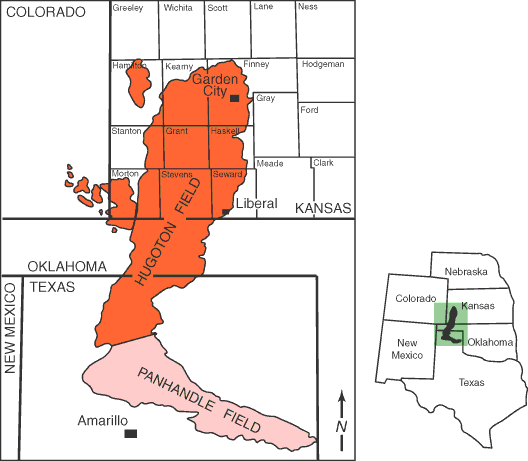| Kansas Geological Survey | Fall 1998 |
Vol. 4.3 |
|
Hugoton Oil and Gas Study
CONTENTS Hugoton study–page 1
|
One
of Kansas’s most important natural resources—the Hugoton gas
area in southwest Kansas—has provided the State with jobs and billions
of dollars in tax revenues for decades. Recently, the Kansas legislature
took steps to insure that the Hugoton will continue to benefit the State
for years to come. The Hugoton is the largest natural gas field in North America and the
second largest in the world. The Kansas portion of the Hugoton has produced
nearly 27 trillion cubic feet of natural gas since its development in
the 1930’s. In 1995, the Hugoton provided about $80 million in severance
taxes to the State, and probably an equal or greater amount from ad valorum,
sales, and income taxes on royalty owners, companies, and employees. This
does not include indirect taxes on the goods and services purchased by
the oil and gas industry; taxes paid by refineries, distributors, and
manufacturers of hydrocarbon-based commodities; or property taxes paid
to the counties. Like any non-renewable resource, gas in the Hugoton won’t last
forever. After years of production, the hydrocarbons are not gone, but
the natural pressure that brings them to the surface is. With plenty of
oil and gas still trapped underground, the challenge is not finding it,
but getting it out of the rocks. The key is understanding the complexities
of the reservoirs. That’s what a new study by the Kansas Geological
Survey is all about. The 1998 Kansas Legislature approved funding for the KGS to study the
oil and gas reservoirs of the Hugoton and its associated fields in southwest
Kansas. Legislative funding of $150,000 per year is to be matched with
private sector contributions. And both the public and industry will benefit:
the State from increased and long-term economic activity and tax revenues,
and the oil and gas industry from improved information that will allow
it to drill and produce the remaining oil and gas reserves more efficiently. This comprehensive study will bring together all the data from the Hugoton field and a 15-county area surrounding it,” said Tim Carr, chief of the Survey’s Petroleum Research Section. “It will provide producers, regulators, royalty owners, and scientists with a common understanding of the area and a solid basis for making decisions about the future of the field.” |
|
The Hugoton field and 15-county study area in Kansas. |
 |
| Online February 10, 2003 Comments to: lbrosius@kgs.ku.edu Kansas Geological Survey URL:http://www.kgs.ku.edu/Publications/GeoRecord/1998/vol4.3/Page1.html |